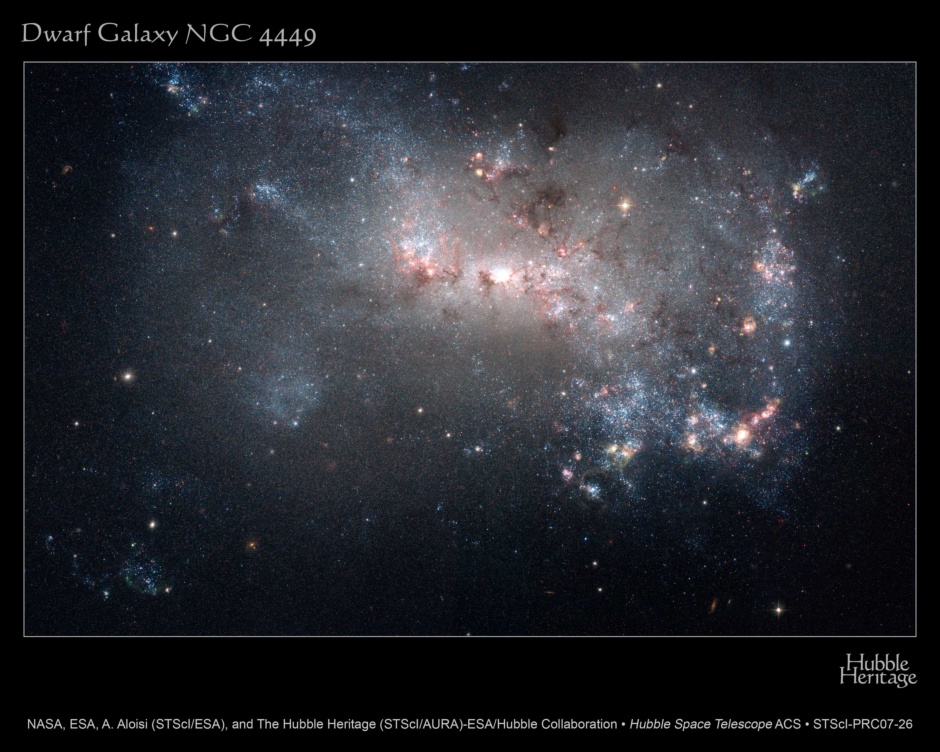7월 4일 미국의 독립기념일을 축하하는 불꽃놀이가 미국의 도시들을 밝히고 있을 때 1250만광년 떨어진 난장이 은하 NGC 4449의 불꽃 역시 내내 타오르고 있었다.
수천수만의 붉은 빛과 푸른 빛이 번쩍이는 이 사진은 허블우주망원경이 촬영한 NGC 4449의 모습이다.
거리는 대략 1300만 광년(4Mpc)이며 사진의 가로는 19000광년(5분각, 6Kpc)의 거리이다.
거대한 별들로 구성된 초고온의 푸르스름한 하얀 별무리들이 전역에 나타나 있고 현재도 별들이 탄생하고 있는 붉은 빛을 띈 지역에서도 어린 별들이 셀수없는 먼지구름들과 함께 골고루 퍼져 있는 모습을 볼 수 있다.
거대한 가스와 먼지로 구성된 검은 구름들이 별빛가운데 검은 그림자를 이루고 있다.
NGC4449는 지난 수십억 년동안 많은 별들을 만들어냈으나 지금은 과거 그 어느때보다도 훨씬 높은 비율로 계속 별들을 탄생시키고 있다.
폭발적이고 격렬한 별의 탄생 활동은 NGC 4449가 별들의 요람으로서 충분한 자격이 있음을 유감없이 나타내고 있다.
현재의 비율로 보았을 때 새로운 별을 탄생시키는데 소요되는 가스에너지는 차후 수십억 년동안 계속 지속될 것으로 보인다.
일반적으로 별들의 탄생은 은하의 중심부에서 진행된다.
그러나 NGC4449의 경우 매우 어린 별들이 은하의 중심부와 주위 은하의 팔 부분에서 계속 관찰되는 것으로 보아 매우 광범위한 지역에서 별들의 탄생이 계속되고 있음을 알 수 있다.
NGC 4449와 같은 거대한 항성 제조기들은 작은 은하와 함께 공생하거나 은하간 충돌을 통해 새로운 별들을 만들어온 원시 은하를 닮았다.
NGC4449는 초기 우주에서 은하들이 탄생하고 진화하면서 무슨일이 생겼을지를 연구하기에는 매우 이상적인 연구소로서 매우 충분하고 상세한 볼거리들을 제공하고 있다.
광범위한 영역에서의 항성 탄생은 일반적으로 은하들간의 상호작용이나 충돌에 의해서 나타나게 된다.
NGC 4449는 사냥개자리의 은하단에 속해있다.
천문학자들은 NGC4449의 왕성한 항성 탄생이 주변의 수많은 은하들과 상호작용의 결과로 발생하는 것으로 추측하고 있다.
이 사진은 2005년 11월에 볼티모어 STScI(the Space Telescope Science Institute) 와 유럽우주항공국의 Alessandra Aloisi가 이끄는 국제과학팀에 의해 촬영되었다.
* '허블사이트'의 게시물들은 허블사이트 http://hubblesite.org 의 뉴스센터 자료들을 번역한 자료들입니다.
본 내용은 2007년 7월 3일 발표된 뉴스입니다.
참고 : NGC 4449를 비롯한 각종 은하 및 은하단에 대한 포스팅은 하기 링크 INDEX를 통해 조회할 수 있습니다.
- 은하 일반 : https://big-crunch.tistory.com/12346976
- 은하단 및 은하군 : https://big-crunch.tistory.com/12346978
- 은하 충돌 : https://big-crunch.tistory.com/12346977
원문>
On July 4, fireworks blaze over the skies of American cities in the annual Independence Day celebrations.
But nearly 12.5 million light-years away in the dwarf galaxy NGC 4449 stellar "fireworks" are going off all the time.
Hundreds of thousands of vibrant blue and red stars blaze in this image taken by NASA's Hubble Space Telescope. Hot bluish-white clusters of massive stars are scattered throughout the galaxy, interspersed with numerous dustier, reddish regions of current star formation. Massive dark clouds of gas and dust are silhouetted against the starlight.
NGC 4449 has been forming stars for several billion years, but currently it is experiencing a star formation event at a much higher rate than in the past. This unusually explosive and intense star formation activity qualifies as a starburst. At the current rate, the gas supply that feeds the stellar production would only last for another billion years or so.
Starbursts usually occur in the central regions of galaxies, but NGC 4449 has more widespread star formation activity, since the very youngest stars are observed both in the nucleus and in streams surrounding the galaxy.
A "global" starburst like NGC 4449 resembles primordial star forming galaxies, which grew by merging with and accreting smaller stellar systems. Since NGC 4449 is close enough to be observed in great detail, it is the ideal laboratory for the investigation of what may have occurred during galactic formation and evolution in the early universe.
It's likely that the current widespread starburst was triggered by interaction or merging with a smaller companion. NGC 4449 belongs to a group of galaxies in the constellation Canes Venatici. Astronomers think that NGC 4449's star formation has been influenced by interactions with several of its neighbors.
This image was taken in November 2005 by an international science team led by Alessandra Aloisi of the Space Telescope Science Institute (STScI) in Baltimore and the European Space Agency (ESA). Other team members include Francesca Annibali (STScI), Claus Leitherer (STScI), Jennifer Mack (STScI), Marco Sirianni (STScI/ESA), Monica Tosi (INAF-OAB), and Roeland van der Marel (STScI).
Hubble's Advanced Camera for Surveys observed the NGC 4449 in blue, visible, infrared, and H-alpha light.
For additional information, contact:
Ray Villard
Space Telescope Science Institute, Baltimore, Md.
(Phone: 410-338-4514; E-mail: villard@stsci.edu)
Lars Lindberg Christensen
ESA/Hubble/ST-ECF, Garching, Germany
(Phone: 49-89-320-06-306; E-mail: lars@eso.org)
Alessandra Aloisi
Space Telescope Science Institute/European Space Agency, Baltimore, Md.
(Phone: 410-338-4519; E-mail: aloisi@stsci.edu)
Object Name: NGC 4449
Image Type: Astronomical
Credit: NASA, ESA, A. Aloisi (STScI/ESA), and The Hubble Heritage (STScI/AURA)-ESA/Hubble Collaboration
'3. 천문뉴스 > 허블사이트' 카테고리의 다른 글
| 소행성 세레스와 베스타 (0) | 2007.09.21 |
|---|---|
| 허블이 촬영한 목성의 대기변화 (0) | 2007.09.20 |
| 젊은 별과 암석부스러기 Disk (0) | 2007.09.19 |
| 별의 최후의 흔적(행성상성운) (0) | 2007.09.19 |
| 허블이 촬영한 깊은 우주 (0) | 2007.09.08 |
